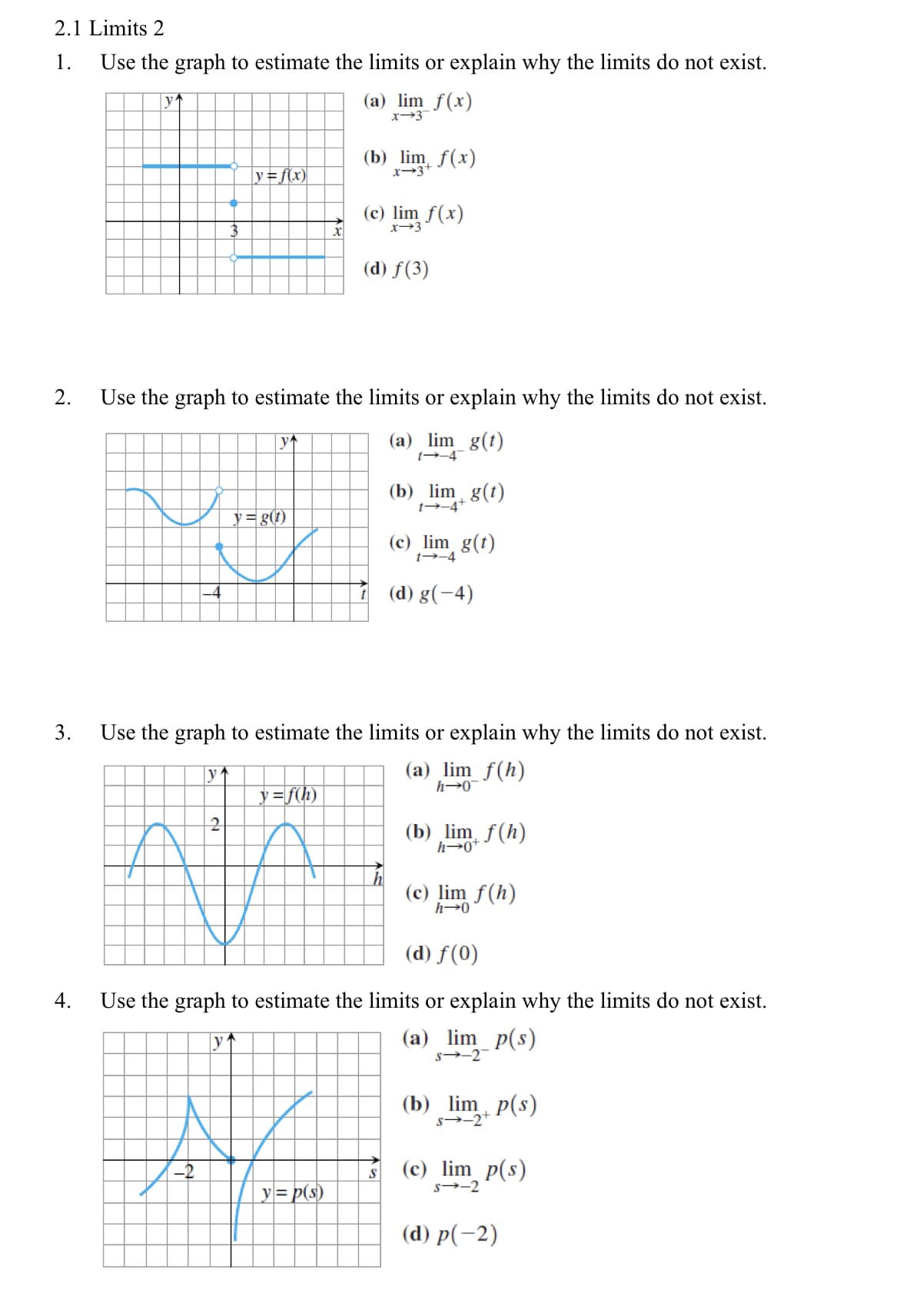2.1 Limits 2 1. Use the graph to estimate the limits or explain why the limits do not exist. y (a) lim f(x) x-3 (b) lim f(x) y = f(x) x-3+ (c) lim f(x) x-3 (d) f(3) 2. Use the graph to estimate the limits or explain why the limits do not exist. y (a) lim_g(t) 1--4 (b) lim_g(t) 1-→-4+ y = g(t) (c) lim g(t) 1--4 1 (d) g(-4) 3. Use the graph to estimate the limits or explain why the limits do not exist. y ₁ (a) lim f(h) h→0 y=f(h) 2 (b) lim f(h) h→0 (c) lim f(h) h→0 (d) f(0) 4. Use the graph to estimate the limits or explain why the limits do not exist. y↑ (a) lim_p(s) S-2 (b) limp(s) 5-2+ (c) lim p(s) 5--2 y=p(s) (d) p(-2) -2 X S
2.1 Limits 2 1. Use the graph to estimate the limits or explain why the limits do not exist. y (a) lim f(x) x-3 (b) lim f(x) y = f(x) x-3+ (c) lim f(x) x-3 (d) f(3) 2. Use the graph to estimate the limits or explain why the limits do not exist. y (a) lim_g(t) 1--4 (b) lim_g(t) 1-→-4+ y = g(t) (c) lim g(t) 1--4 1 (d) g(-4) 3. Use the graph to estimate the limits or explain why the limits do not exist. y ₁ (a) lim f(h) h→0 y=f(h) 2 (b) lim f(h) h→0 (c) lim f(h) h→0 (d) f(0) 4. Use the graph to estimate the limits or explain why the limits do not exist. y↑ (a) lim_p(s) S-2 (b) limp(s) 5-2+ (c) lim p(s) 5--2 y=p(s) (d) p(-2) -2 X S
Calculus: Early Transcendentals
8th Edition
ISBN:9781285741550
Author:James Stewart
Publisher:James Stewart
Chapter1: Functions And Models
Section: Chapter Questions
Problem 1RCC: (a) What is a function? What are its domain and range? (b) What is the graph of a function? (c) How...
Related questions
Question

Transcribed Image Text:2.1 Limits 2
1.
Use the graph to estimate the limits or explain why the limits do not exist.
y'
(a) lim_ f(x)
x 3
(b)
y=f(x)
x→3+ √(x)
(c) lim f(x)
(d) f(3)
2.
Use the graph to estimate the limits or explain why the limits do not exist.
y^
(a) lim_g(t)
t→-4
(b) lim_g(t)
1-→-4+
y = g(t)
(c) lim g(t)
1→-4
7(d) g(-4)
3. Use the graph to estimate the limits or explain why the limits do not exist.
(a)_lim_ƒ(h)
h→0
y^
2
y=f(h)
(b) lim f(h)
h→0+
(c) lim f(h)
h→0
(d) f(0)
4.
Use the graph to estimate the limits or explain why the limits do not exist.
VA
(a) lim_p(s)
S-2
(b) limp(s)
S→-2+
(c) lim_p(s)
y=p(s)
S→-2
(d) p(-2)
X
S
Expert Solution
This question has been solved!
Explore an expertly crafted, step-by-step solution for a thorough understanding of key concepts.
Step by step
Solved in 3 steps with 3 images

Recommended textbooks for you

Calculus: Early Transcendentals
Calculus
ISBN:
9781285741550
Author:
James Stewart
Publisher:
Cengage Learning

Thomas' Calculus (14th Edition)
Calculus
ISBN:
9780134438986
Author:
Joel R. Hass, Christopher E. Heil, Maurice D. Weir
Publisher:
PEARSON

Calculus: Early Transcendentals (3rd Edition)
Calculus
ISBN:
9780134763644
Author:
William L. Briggs, Lyle Cochran, Bernard Gillett, Eric Schulz
Publisher:
PEARSON

Calculus: Early Transcendentals
Calculus
ISBN:
9781285741550
Author:
James Stewart
Publisher:
Cengage Learning

Thomas' Calculus (14th Edition)
Calculus
ISBN:
9780134438986
Author:
Joel R. Hass, Christopher E. Heil, Maurice D. Weir
Publisher:
PEARSON

Calculus: Early Transcendentals (3rd Edition)
Calculus
ISBN:
9780134763644
Author:
William L. Briggs, Lyle Cochran, Bernard Gillett, Eric Schulz
Publisher:
PEARSON

Calculus: Early Transcendentals
Calculus
ISBN:
9781319050740
Author:
Jon Rogawski, Colin Adams, Robert Franzosa
Publisher:
W. H. Freeman


Calculus: Early Transcendental Functions
Calculus
ISBN:
9781337552516
Author:
Ron Larson, Bruce H. Edwards
Publisher:
Cengage Learning